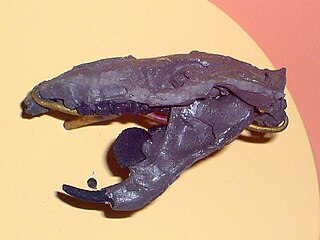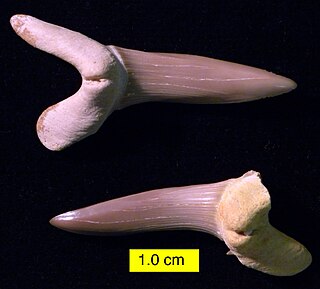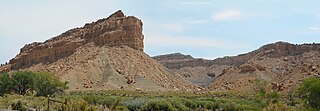
Myliobatiformes is one of the four orders of batoids, cartilaginous fishes related to sharks. They were formerly included in the order Rajiformes, but more recent phylogenetic studies have shown the myliobatiforms to be a monophyletic group, and its more derived members evolved their highly flattened shapes independently of the skates.

Meniscoessus is a genus of extinct multituberculates from the Upper Cretaceous Period that lived in North America.

Cimolomys is a mammal genus from the Upper Cretaceous of North America. It was a member of the extinct order Multituberculata within the suborder Cimolodonta and family Cimolomyidae.

Denversaurus is a genus of panoplosaurin nodosaurid dinosaur from the late Maastrichtian of Late Cretaceous Western North America. Although at one point treated as a junior synonym of Edmontonia by some taxonomists, current research indicates that it is its own distinct nodosaurid genus.

Scapanorhynchus is an extinct genus of goblin shark that lived during the Cretaceous period, from the Aptian to the end of the Maastrichtian. Later records, such as those from the Miocene assigned to the species S. subulatus, are highly dubious and may be misidentified sand sharks.

Symmoriiformes is an extinct order of stem-group holocephalians. Originally named Symmoriida by Zangerl (1981), it has subsequently been known by several other names. Lund (1986) synonymized the group with Cladodontida, while Maisey (2008) corrected the name to Symmoriiformes in order to prevent it from being mistaken for a family. The symmoriiform fossils record begins during the late Devonian. Most of them died out at the start of the Permian, but Dwykaselachus is known from the Artinskian-Kungurian of South Africa. Teeth described from the Valanginian of France and Austria indicate that members of the family Falcatidae might have survived until the Early Cretaceous; however, these teeth were also argued to be more likely neoselachian teeth.

Schizorhiza is an extinct genus of schizorhizid sclerorhynchoid that lived during the Late Cretaceous. It contains one valid species, Schizorhiza stromeri. It lived from the Campanian to Maastrichtian, and its fossils have been found in Africa, the Middle East, North America, and South America.

The Pierre Shale is a geologic formation or series in the Upper Cretaceous which occurs east of the Rocky Mountains in the Great Plains, from Pembina Valley in Canada to New Mexico.

Hybodontiformes, commonly called hybodonts, are an extinct group of shark-like cartilaginous fish (chondrichthyans) which existed from the late Devonian to the Late Cretaceous. Hybodonts share a close common ancestry with modern sharks and rays (Neoselachii) as part of the clade Euselachii. They are distinguished from other chondrichthyans by their distinctive fin spines and cephalic spines present on the heads of males. An ecologically diverse group, they were abundant in marine and freshwater environments during the late Paleozoic and early Mesozoic, but were rare in open marine environments by the end of the Jurassic, having been largely replaced by modern sharks, though they were still common in freshwater and marginal marine habitats. They survived until the end of the Cretaceous, before going extinct.

Jeletzkytes is an extinct genus of scaphatoid ammonite from the Upper Cretaceous (Maastrichtian) of North America named and described by Riccardi, 1983. In overall form Jeletzkytes closely resembles the genus Scaphites.

Cylindracanthus is an extinct, enigmatic genus of marine ray-finned fish with fossils known throughout North America, Europe, Asia and Africa from the Late Cretaceous to the late Eocene, with potential Oligocene records and a possible Miocene record also known. It is exclusively known from its distinctive partial remains, which are long cylindrical bony spines that are usually considered rostrum fragments, as well as some associated teeth. These spines are abundant & widespread throughout this timespan, and are useful indicators of a nearshore marine environment, but the taxonomic identity of the fish is still highly uncertain and debated.

Onchopristis is an extinct genus of sclerorhynchoid from the Cretaceous of North Africa, Europe, and North America. Its name is derived from the Ancient Greek ónkos and prístis. It contains two valid species, O. numida and O. dunklei, though some researchers argue that both may be considered a single taxon with variation in morphology caused by a wide geographical range. Specimens of Onchopristis have been discovered in coastal and fluvial deposits dated from the Barremian to the Maastrichtian ages, making this genus one of the oldest and longest-lived sclerorhynchoid genera.

Lonchidion is a genus of extinct hybodont in the family Lonchidiidae. The genus first appears in the fossil record during the Middle Triassic (Ladinian) and was among the last surviving hybodont genera, with its youngest known fossils dating to the very end of the Cretaceous (Maastrichtian).

Meristodonoides is an extinct genus of hybodont known from the mid-late Cretaceous, with potential records dating back to the Jurassic. It is one of a number of hybodont genera composed of species formerly assigned to Hybodus.

Cretalamna is a genus of extinct otodontid shark that lived from the latest Early Cretaceous to Eocene epoch. It is considered by many to be the ancestor of the largest sharks to have ever lived, such as Otodus angustidens, Otodus chubutensis, and Otodus megalodon.
This list of fossil fish species is a list of taxa of fish that have been described during the year 2012. The list only includes taxa at the level of genus or species.
The Arkadelphia Marl, also called the Arkadelphia Formation, is a geologic formation in Arkansas in Clark, Nevada, and Hempstead counties. It preserves fossils dating back to the late Maastrichtian stage of the Cretaceous period.

The Ferron Sandstone Member of the Mancos Shale is a geologic unit in Utah. It preserves fossils dating back to the Cretaceous period; and more specifically the middle Turonian.

Protosqualus was a genus of dogfish shark that existed during the Cretaceous. Fossils have been found in Europe, East Asia, Antarctica, Australia, India and South America. The type species is Protosqualus sigei, which was found around an Albian aged deposit in France. There are 6 species which can be differentiated by distinct features in their teeth. Some species show some level of heterodonty, for example Protosqualus barringtonensis shows a rather high level of heterodonty within its teeth. The oldest specimens are from the Speeton Clay Formation. Protosqualus teeth are quite common in the Grey Chalk deposit of England. The genus went extinct at the end of the Cretaceous during the Cretaceous–Paleogene extinction event, with the last species in the genus being Protosqualus argentinensis from southern Argentina as well as possibly being from earlier deposits in India.
















